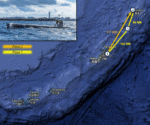Germany and Japan are reportedly in preliminary discussions to co-develop a next-generation turbofan engine that would power an upgraded version of the Taurus KEPD 350 air-launched cruise missile. The move signals deepening defense-industrial ties between two technologically advanced nations seeking to enhance their long-range precision strike capabilities amid growing regional threats.
Strategic Context: Why Germany and Japan Are Collaborating
The proposed collaboration emerges at a time when both Berlin and Tokyo are reassessing their strategic postures. For Germany, the Russian invasion of Ukraine has triggered a major shift in defense spending and capability modernization under Chancellor Olaf Scholz’s Zeitenwende policy. For Japan, North Korea’s expanding missile arsenal and China’s assertiveness in the East China Sea have prompted Tokyo to double its defense budget over five years and pursue counterstrike capabilities.
Both nations operate or plan to operate air-launched cruise missiles as part of their deterrence strategies. Germany is already a user of the Taurus KEPD 350 missile developed by Taurus Systems GmbH—a joint venture between MBDA Deutschland (67%) and Saab Dynamics (33%). Meanwhile, Japan is developing indigenous long-range strike options but lacks fielded systems with the range and penetration characteristics of the Taurus.
Taurus KEPD 350: A Proven but Aging Platform
The current Taurus KEPD 350 is a stealthy subsonic cruise missile with a range exceeding 500 km. It uses a Williams International F107-WR-105 turbofan engine (also used on AGM-86 ALCM variants), enabling low-level terrain-following flight. Its warhead—a dual-stage MEPHISTO penetrator—is designed to defeat hardened targets such as bunkers or command centers.
However, the F107 engine is aging, with limited production support remaining in the U.S., raising sustainability concerns for future upgrades or exports. Moreover, newer propulsion technologies could offer improved fuel efficiency, reduced infrared signature, or extended range—key factors for survivability against modern integrated air defenses.
New Engine Goals: Range Extension and Export Viability
The proposed next-generation turbofan would aim to replace the legacy F107 while enhancing overall performance metrics:
- Extended Range: Targeting ranges beyond 700–800 km to match or exceed emerging threats like Russia’s Kh-101 or China’s CJ-10A.
- Lower IR Signature: Using advanced cooling techniques or materials to reduce detectability by IRST-equipped fighters or SHORAD systems.
- Sustainability: Ensuring secure supply chains by localizing production in Europe and/or Japan.
If successful, this propulsion upgrade could not only sustain German Air Force stocks but also open new export avenues—especially if paired with Japanese F-15JSI fighters or future sixth-gen platforms like GCAP (Global Combat Air Programme).
IHI Corporation Likely Japanese Partner; German OEM TBD
On the Japanese side, IHI Corporation appears best positioned as an industrial partner. IHI has extensive experience developing small turbofans such as those used on the ASM-3 supersonic anti-ship missile (XF5-derived) and has supported engines for both commercial jets (e.g., PW1100G-JM) and military aircraft like the F-3 demonstrator.
The German side is less clear. While MTU Aero Engines has experience with military propulsion systems—including Eurofighter EJ200 modules—it does not currently produce small turbofans suitable for cruise missiles. MBDA Deutschland may coordinate integration efforts via its stake in Taurus Systems GmbH but would likely rely on subcontractors for actual engine development unless Saab Dynamics contributes via Swedish suppliers.
Diplomatic Hurdles: MTCR Compliance and U.S. Interests
A key challenge will be ensuring compliance with Missile Technology Control Regime (MTCR) guidelines—which restrict exports of systems capable of delivering ≥500 kg payloads over ≥300 km—to avoid proliferation concerns. Both Japan and Germany are MTCR members; any jointly developed system would need safeguards against unauthorized transfer.
Additionally, U.S. sensitivities could arise if joint development threatens Lockheed Martin’s JASSM family dominance among NATO allies or undermines American control over propulsion tech like the F107 core architecture. However, if no U.S.-origin components are used in the new engine design—and if it remains within MTCR limits—Washington may tacitly approve under alliance burden-sharing logic.
Tactical Implications: Enhancing Penetration Capabilities
An upgraded Taurus powered by an advanced turbofan could significantly improve tactical options for both countries:
- Germany: Offers enhanced standoff capability from Eurofighter Typhoons against heavily defended targets deep inside contested zones such as Kaliningrad or Belarusian bases supporting Russian operations.
- Japan: Could provide survivable first-strike options against North Korean mobile launchers or Chinese radar installations without relying solely on U.S.-supplied Tomahawk missiles under Foreign Military Sales (FMS).
Status of Talks and Timeline Uncertainty
No formal contract has been signed yet; discussions remain exploratory according to sources cited by Nikkei Asia. If feasibility studies proceed smoothly through FY2025–2026—with government funding from both sides—engine testbeds might emerge by late this decade. Full integration into an upgraded KEPD variant could follow post-2030 depending on software/hardware compatibility trials.
A Broader Trend Toward Multilateral Strike Capability Development
This potential German-Japanese partnership fits into a wider trend where mid-tier powers seek indigenous solutions to reduce reliance on U.S.-dominated munitions ecosystems while enhancing interoperability among trusted allies:
- Korea-U.K.-Italy GCAP program: Sharing sixth-gen fighter technologies including sensors and weapons integration frameworks.
- NATO DIANA initiative: Promoting transatlantic innovation pipelines across AI-enabled munitions domains.
- AUKUS Pillar II: Exploring hypersonics cooperation that may eventually influence subsonic strike assets too.
Conclusion: A Calculated Step Toward Sovereign Strike Autonomy
If realized, this joint effort between Tokyo and Berlin could yield more than just an engine—it may catalyze deeper defense-industrial convergence across Europe and Asia while reshaping how middle powers project force at distance under contested conditions. The success of such programs will depend heavily on political alignment, technical feasibility, export controls—and above all—the ability to deliver timely capability gains amid rapidly evolving threat environments.










